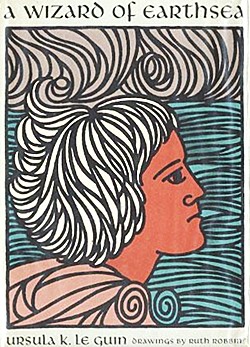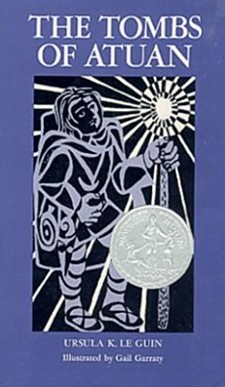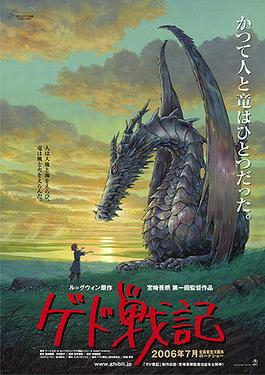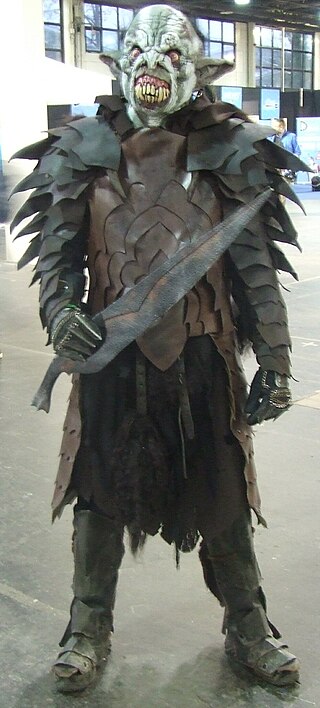Related Research Articles

A Wizard of Earthsea is a fantasy novel written by American author Ursula K. Le Guin and first published by the small press Parnassus in 1968. It is regarded as a classic of children's literature and of fantasy, within which it is widely influential. The story is set in the fictional archipelago of Earthsea and centers on a young mage named Ged, born in a village on the island of Gont. He displays great power while still a boy and joins a school of wizardry, where his prickly nature drives him into conflict with a fellow student. During a magical duel, Ged's spell goes awry and releases a shadow creature that attacks him. The novel follows Ged's journey as he seeks to be free of the creature.

Ursula Kroeber Le Guin was an American author. She is best known for her works of speculative fiction, including science fiction works set in her Hainish universe, and the Earthsea fantasy series. Her work was first published in 1959, and her literary career spanned nearly sixty years, producing more than twenty novels and over a hundred short stories, in addition to poetry, literary criticism, translations, and children's books. Frequently described as an author of science fiction, Le Guin has also been called a "major voice in American Letters". Le Guin said she would prefer to be known as an "American novelist".

The Tombs of Atuan is a fantasy novel by the American author Ursula K. Le Guin, first published in the Winter 1970 issue of Worlds of Fantasy, and published as a book by Atheneum Books in 1971. It is the second book in the Earthsea series after A Wizard of Earthsea (1969). The Tombs of Atuan was a Newbery Honor Book in 1972.

The Earthsea Cycle, also known as Earthsea, is a series of high fantasy books written by the American author Ursula K. Le Guin. Beginning with A Wizard of Earthsea (1968), The Tombs of Atuan, (1970) and The Farthest Shore (1972), the series was continued in Tehanu (1990), and Tales from Earthsea and The Other Wind. In 2018, all the novels and short stories were published in a single volume, The Books of Earthsea: The Complete Illustrated Edition, with artwork by Charles Vess.

The Farthest Shore is a fantasy novel by the American author Ursula K. Le Guin, first published by Atheneum in 1972. It is the third book in the series commonly called the Earthsea Cycle. As the next Earthsea novel, Tehanu, would not be released until 1990, The Farthest Shore is sometimes referred to as the final book in the so-called Earthsea trilogy, beginning with A Wizard of Earthsea and The Tombs of Atuan. Decades later, The Farthest Shore follows the wizard Ged in his final adventure.

The Other Wind is a fantasy novel by the American author Ursula K. Le Guin, published by Harcourt in 2001. It is the fifth and final novel set in the fictional archipelago Earthsea. It won the annual World Fantasy Award for Best Novel and was runner up for the Locus Award, Best Fantasy Novel, among other nominations.

Tehanu, initially subtitled The Last Book of Earthsea, is a fantasy novel by the American author Ursula K. Le Guin, published by Atheneum in February 1990. It is the fourth novel set in the fictional archipelago Earthsea, published almost twenty years after the first three Earthsea novels (1968–1972), and not the last, despite its original subtitle.

Rocannon's World is a science fiction novel by American writer Ursula K. Le Guin, her literary debut. Published in 1966, it appeared as an Ace Double, with an opening entitled "Semley's Necklace" that first appeared as the stand-alone story, "The Dowry of Angyar", in Amazing Stories in September 1964. The novel is one of several of Le Guin's works taking place in the same universe and with relationships of characters and history, works that have been termed the Hainish Cycle. Its story presents many elements of heroic fantasy.

Tales from Earthsea is a collection of fantasy stories and essays by American author Ursula K. Le Guin, published by Harcourt in 2001. It serves as an accompaniment to the five novels of the Earthsea cycle, all set in the fictional archipelago Earthsea.
"The Rule of Names" is a short story by American writer Ursula K. Le Guin, first published in the April 1964 issue of Fantastic and reprinted in collections such as The Wind's Twelve Quarters. This story and "The Word of Unbinding" convey Le Guin's initial concepts for the Earthsea realm, including its places and physical manifestation. Most of the characters from the novels do not make an appearance, with the exception of the dragon Yevaud. Both stories help explain the foundations of the Earthsea realm, in particular the importance of true names to magic.
"The Word of Unbinding" is a short story by American writer Ursula K. Le Guin, first published in the January 1964 issue of Fantastic, and reprinted in collections such as The Wind's Twelve Quarters. In this story, the Earthsea realm, later made setting of the novel A Wizard of Earthsea, was first introduced. Along with the story "The Rule of Names", this story conveys Le Guin's initial concepts for the Earthsea realm, including its places and physical manifestation, but not the characters appearing in the novels.

Legend of Earthsea is a two-part television fantasy miniseries produced for the Sci-Fi Channel and aired in 2004. It is an adaptation of the Earthsea novels by Ursula K. Le Guin. The teleplay was written by Gavin Scott, and the series was directed by Robert Lieberman. Legend of Earthsea is an American-Canadian co-production that was filmed on location in Vancouver, British Columbia.
A true name is a name of a thing or being that expresses, or is somehow identical to, its true nature. The notion that language, or some specific sacred language, refers to things by their true names has been central to philosophical study as well as various traditions of magic, religious invocation and mysticism (mantras) since antiquity.

Changing Planes is a 2003 collection of short stories by Ursula K. Le Guin. Each chapter describes a different world and the society that inhabits it; these societies share similarities to Earth's cultures in some respects, but may be notably dissimilar in other respects. Many of the chapters are brief vignettes or ethnographic profiles of the societies they describe.

Tales from Earthsea is a 2006 Japanese anime epic fantasy film co-written and directed by Gorō Miyazaki in his directorial debut, animated by Studio Ghibli for the Nippon Television Network, Dentsu, Hakuhodo DY Media Partners, Buena Vista Home Entertainment, Mitsubishi and Toho, and distributed by the latter company. The film is based on a combination of plot and character elements from the first four books of Ursula K. Le Guin's Earthsea series, as well as Hayao Miyazaki's graphic novel Shuna's Journey. The film's English title is taken from the collection of short stories published in 2001.

Ursula K. Le Guin (1929–2018) was an American author of speculative fiction, realistic fiction, non-fiction, screenplays, librettos, essays, poetry, speeches, translations, literary critiques, chapbooks, and children's fiction. She was primarily known for her works of speculative fiction. These include works set in the fictional world of Earthsea, stories in the Hainish Cycle, and standalone novels and short stories. Though frequently referred to as an author of science fiction, critics have described her work as being difficult to classify.
Ged is the true name of a fictional character in Ursula K. Le Guin's Earthsea realm. He is introduced in A Wizard of Earthsea, and plays both main and supporting roles in the subsequent Earthsea novels. In most of the Earthsea books he goes by the Hardic name Sparrowhawk; as a child he is known as Duny.
Earthsea is a fictional world created by American writer Ursula K. Le Guin. Introduced in her short story "The Word of Unbinding", published in 1964, Earthsea became the setting for a further six books, beginning with A Wizard of Earthsea, first published in 1968, and continuing with The Tombs of Atuan, The Farthest Shore, Tehanu, Tales from Earthsea and The Other Wind. Nine short stories by Le Guin are also set in Earthsea; the earliest two in her 1975 collection of short stories The Wind's Twelve Quarters, five in Tales from Earthsea, and the final two in an illustrated collection in The Books of Earthsea. Collectively, the series is simply known as Earthsea.

Although fantasy had long existed in various forms around the world before his time, J. R. R. Tolkien has been called the "father of fantasy", and The Lord of the Rings its centre. That novel, published in 1954–5, enormously influenced fantasy writing, establishing in particular the form of high or epic fantasy, set in a secondary or fantasy world in an act of mythopoeia. The book was distinctive at the time for its considerable length, its "epic" feel with a cast of heroic characters, its wide geography, and its battles. It involved an extensive history behind the action, an impression of depth, multiple sentient races and monsters, and powerful talismans. The story is a quest, with multiple subplots. The novel's success demonstrated that the genre was commercially distinct and viable.
References
- Bernardo, Susan M.; Murphy, Graham J. (2006). Ursula K. Le Guin: A Critical Companion (1st ed.). Westport, CT: Greenwood Press. ISBN 0-313-33225-8.